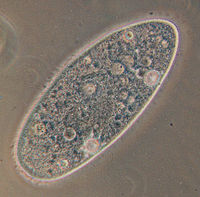Paramecium
| Paramecium | ||||||||||||
|---|---|---|---|---|---|---|---|---|---|---|---|---|
 Paramecium aurelia | ||||||||||||
| Scientific classification | ||||||||||||
|
Paramecium is a well-known genus of ciliate protozoa, commonly studied as a representative of that group. Paramecia are unicellular and slipper-shaped, ranging from 50 to 300 μm in length, depending on species. Simple cilia, tiny hairlike filaments, cover the body, and there is a deep oral groove, containing inconspicuous compound oral cilia, as found in other peniculids. These cilia aid in both movement and in moving food to the oral cavity. Food enters the food vacuoles and is digested with the aid of hydorchloric acid and enzymes (Raven and Johnson 1996). When digestion is complete, the remaining food content is emptied into pellicles, known as cytoproct. Osmoregulation is carried out by a pair of contractile vacuoles, which actively expel water absorbed by osmosis from the surroundings.
Paramecia have two different types of nuclei within their cells: micronuclei, which contain normal diploid chromosomes, divide by meiosis, and undergo genetic recombination; and macronuclei, which are derived from the micronuclei but contain multiple copies of the genome and the DNA is divided smaller than individual chromosomes (Raven and Johnson 1996).
Paramecia are widespread in freshwater environments, and are especially common in scums. Paramecia are attracted by acidic conditions. Paramicia usually reproduce asexually, however, when food supplies are low, they may reproduce through a form of conjugation, the transfer of genetic material through cell-to-cell contact. Progeny from conjugation must reproduce asexually reproduce 50 times before they are able to perform conjugation, after which their biological clocks are restarted, allowing for conjugation. Death follows after about 100 generations, because of protein degradation around the gullet, which prevents them from finding a mate.
The division into species is still in flux—for instance, P. aurelia has recently been divided into 14 species—but the following are representative:
- P. aurelia (Ehrenberg), 1838
- Paramecium bursaria (Ehrenberg) Focker, 1836
- P. calkinsi Woodruff, 1921
- P. caudatum Ehrenberg, 1838
- P. duboscqui Chatton and Brachon, 1933
- P. jenningsi Diller & Earl, 1958
- P. multimicronucleatum Powers & Mitchell, 1910
- P. nephridiatum von Gelei, 1925
- P. polycaryum Woodruff, 1923
- P. putrinum Claparede & Lachmann, 1858
- P. trichium Stokes, 1885
- P. woodruffi Wenrich, 1928
A number of doubtful species have also been recorded.
Paramecium in popular culture
- In a popular computer program, Chip's Challenge, the main character is chased by a cartoon paramecium, one of the many monsters that he must overcome.
ReferencesISBN links support NWE through referral fees
- Margulis, L., H.I. McKhann, and L. Olendzenski. 1992. Illustrated Glossary of Protoctista. Boston: Jones and Bartlett.
- Raven, P.H., Johnson, G.B. 1996. Biology. Wm. C. Brown Publishers, 4th ed.
- Wichterman, R. 1986. The Biology of Paramecium. New York: Plenum Press.
Credits
New World Encyclopedia writers and editors rewrote and completed the Wikipedia article in accordance with New World Encyclopedia standards. This article abides by terms of the Creative Commons CC-by-sa 3.0 License (CC-by-sa), which may be used and disseminated with proper attribution. Credit is due under the terms of this license that can reference both the New World Encyclopedia contributors and the selfless volunteer contributors of the Wikimedia Foundation. To cite this article click here for a list of acceptable citing formats.The history of earlier contributions by wikipedians is accessible to researchers here:
The history of this article since it was imported to New World Encyclopedia:
Note: Some restrictions may apply to use of individual images which are separately licensed.